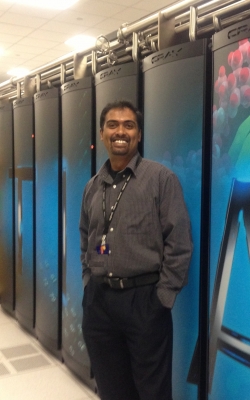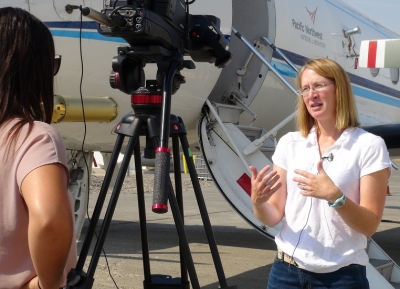New Roles at ARM Reflect Organizational Changes
Published: 14 September 2015

Giri Palanisamy and Jennifer Comstock are two staff members who have recently undertaken new professional roles within the ARM Climate Research Facility. Both positions reflect the larger reconfiguration outlined in the Decadal Vision, which calls for accelerating the application of ARM observations and data processing for model evaluation and development. During this extensive effort, redefining certain roles provides improved clarification of responsibilities and thus helps foster greater cohesion throughout the multi-laboratory system. Ultimately, the ARM Facility hopes to cultivate an adaptive organizational environment conducive to yielding more robust scientific data and refined processes for incorporating them into existing global climate models.
As part of the organizational changes, the ARM Facility is implementing the Large-Eddy Simulation (LES) ARM Symbiotic Simulation and Observation, or LASSO, modeling project. By increasing the density and spatial coverage of measurement capabilities, ARM is effectively moving from a vertical column of measurements to multi-dimensional measurements that provide 4-dimensional views of the atmosphere in a defined space. These data will form the basis of the LES modeling, which will in turn be used to better understand gaps where measurements are not possible, and to study detailed atmospheric processes across a range of scales. These high-resolution model simulations will be run on a routine basis, thus creating a powerful new capability for furthering ARM’s mission.
The ARM Architecture and Services Strategy Team was put in place to craft a comprehensive, multi-year re-architecture of ARM’s current computational environment to accommodate the influx of very large data sets produced from new scanning-cloud and precipitation radars and vast amounts of quantitative information that will be generated from improved high-resolution model workflows. As the manager of this group, Palanisamy facilitates teamwork among its members and ensures the future computational framework possesses the capacity to efficiently respond to emerging operational demands. This strategy and implementation plan, referred to as the “ARM Adaptive Architecture” and currently under development, is able to accommodate a much larger capacity of data than before.
Giri Palanisamy’s new role as ARM Architecture and Services Strategy Team Manager, allows him to facilitate teamwork among the Architecture and Services Strategy Team to craft a comprehensive, multi-year plan for ARM’s computational environment. This internal strategy and implementation plan, referred to as the “ARM Adaptive Architecture,” is able to accommodate a much larger capacity of data than before.
With the influx of very large data sets from the new volume scanning cloud and precipitation radar systems, in addition to the vast amounts of quantitative information that will be generated from improved high-resolution model workflows, “this re-architecture is more important than ever for successful product delivery,” Palanisamy said.
In his other new role as Data Services Operations Manager, Palanisamy deals more extensively with the entire product delivery process; from the time of collection to distribution. Previously, as the Deputy Archive Technical Leader, Palanisamy was responsible only for the ARM Data Archive. With such massive quantities of data, a new role was needed to better coordinate data services across the ARM Facility. Palanisamy is now responsible for the Data Management Facility, External Data Center, and Site Data Systems, as well. Coordinating data stored within these four entities can be complex; requiring measurements contained in data files to be processed into meaningful units, documented for quality, archived and finally made available for public consumption through the ARM Data Archive.

Throughout the product delivery process Palanisamy works closely with Jennifer Comstock to ensure operational needs are defined and associated engineering tasks are executed according to organizational standards.
In her new role as Engineering and Process Manager, Comstock is responsible for ensuring consistency and refinement of all existing engineering workflow processes; including those related to product delivery. To guarantee procedures are as current and relevant as possible, she works closely with five engineering leads to develop implementation strategies, which integrate both engineering and operations activities.
In addition, Comstock provides transparent internal feedback mechanisms to facilitate regular process improvement. Although the Engineering Manager role is not new and previously part of the ARM Technical Director’s role, the responsibilities have been expanded to encompass a broader intersection of the ARM Facility. Because of the increased and very important work scope, the Engineering Manager role needed to be its own position.
In addition to workflow processes, as the Science Products and Measurements Technical Coordinator—a new position within ARM—Comstock assesses existing ARM products and measurements to establish overarching program priorities. She ensures these priorities align with both DOE’s mission and the needs of the research community; thus directly fulfilling ARM’s next generation strategy to improve facility and community interactions.
Although Palanisamy and Comstock’s individual roles may differ, both make a daily impact on the advancement of science through their unique, pivotal contributions to ARM and willingness to take on new challenges. Through these organizational changes and others, the ARM Facility hopes to exert an enhanced impact on the research community by accelerating the understanding of key atmospheric processes and their representation in global climate models.
The ARM Climate Research Facility is a DOE Office of Science user facility. The ARM Facility is operated by nine DOE national laboratories, including .
Keep up with the Atmospheric Observer
Updates on ARM news, events, and opportunities delivered to your inbox
ARM User Profile
ARM welcomes users from all institutions and nations. A free ARM user account is needed to access ARM data.


















